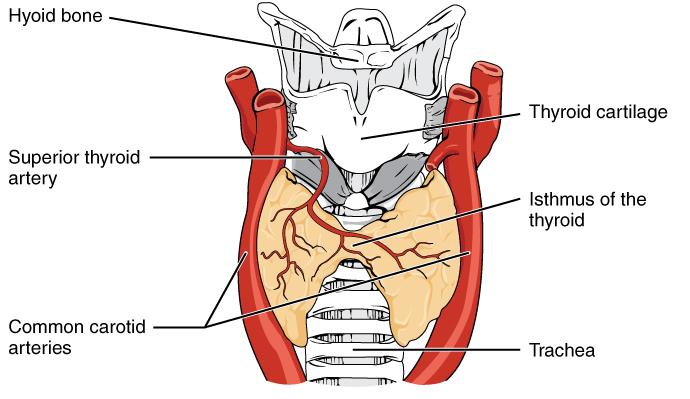Joseph R. Anticaglia MD
Medical Advisory Board
What Is It?
The thyroid gland is a butterfly shaped endocrine gland located in the neck below the Adam’s apple or thyroid cartilage, and in front of the windpipe (trachea). It consists of right and left thyroid lobes (wings), joined together by a narrow strip of thyroid tissue called the isthmus.
Follicle cells are the functional units that make up the thyroid gland that produce, store, and secrete the thyroid hormone directly into the blood. Ordinarily, you cannot see or feel a healthy thyroid gland. However, the gland is susceptible to diseases, and can become visible, and palpable because of its overactivity, or underactivity, or tumor growth.

What Does It Do?
The thyroid’s mission is to keep your metabolism running smoothly. It does its job by producing the thyroid hormone that transforms the food we eat, quickly and efficiently, into energy the body needs to grow, reproduce and remain healthy.
The thyroid hormone targets specific cells of virtually every organ in the body including bone, central nervous system, the heart, gastrointestinal system, and reproductive system to regulate, and energize a person’s metabolism. The body makes one hormone in two different forms.
T4 and T3
T4 accounts for approximately eighty per cent of the thyroid hormone produced by the thyroid gland. It’s a storage hormone that does not have a direct effect on your metabolism. It is held in reserve until it gets the signal to enter the bloodstream. Once T4 is in the blood, the body can convert it to the active T3 hormone by the removal of iodine from its chemical structure. T4 lasts in the body about three weeks.
T3
T3 is the active form of the thyroid hormone which greatly effects the metabolism of various organs. This hormone lasts in the body two to three days. T3 and T4 are produced 24/7.
TSH — the Pituitary—Thyroid Connection
The brain’s pituitary gland is the control center for the thyroid gland. It regulates the outflow or secretion of T4, and T3 into the bloodstream by releasing its own hormone TSH, or thyroid stimulating hormone into the blood.
When the blood level of T3 is low, the pituitary releases more TSH into the bloodstream stimulating thyroid’s follicular cells to produce, and release more of the thyroid T3 hormone.
Counter-intuitively, a high laboratory blood level of TSH indicates not enough of thyroid T3 hormone flowing in the bloodstream, and hypothyroidism.
On the other hand, a low laboratory blood level of TSH indicates too much of the thyroid T3 hormone circulating in the blood, and hyperthyroidism.
Iodine and the Thyroid Gland
Iodine is an essential trace mineral that is used by the thyroid gland to make thyroid hormone. Iodine is part of the chemical structure of the Thyroxine, T4. Since it is an “essential” trace element, the body does not produce iodine, it needs to be included in your diet.
When the dietary intake of iodine is insufficient, inadequate amounts of thyroid hormone is produced leading to hypothyroidism, and in severe cases goiter. It’s particularly important in pregnant women since iodine deficiency can cause brain damage in children (cretinism).

In short, the thyroid hormone affects virtually every organ system in the body, and the gland is a vital part of the endocrine system.
The brain’s pituitary gland releases the hormone TSH into the bloodstream, instructing the thyroid gland to produce more or less thyroid hormone. A high laboratory level of TSH equals hypothyroidism. A low level of TSH equals hyperthyroidism.
References
- Jessica Farebrother, et al; Excess Iodine Intake: sources. assessment. and effects on thyroid function; Ann. N. Y. Acad Sci.; June 2019
- CFCF; Diagrammatic view of thyroid gland;
- R. Sapin et al; Thyroxine (T4) and triiodothyronine (T3) determinations: Ann Bio Clin (Paris); July-August 2003
- Muhammad A. Shahid, et al; Physiology, Thyroid Hormone; StatPearls, May 8, 2022
Glossary
- A gland is an organ that makes chemical substances, such as digestive juices, hormones, sweat, or tears.
- Endocrine glands secrete hormones directly into the bloodstream.
- T3 — Triiodothyronine
- T4 — Thyroxine Most people requiring thyroid medication are on the T4 hormone — Synthroid — Levothyroxine
- The follicular cells of the thyroid produce mostly thyroid T4 hormone, approximately, (T4 80%, and T3 20%).
- Iodine is an essential trace mineral needed by the thyroid gland to make thyroid hormone. Because it is an “essential” mineral, we need to get it from the diet because the body does not make iodine.
- C cells are the cells in the thyroid gland that produce calcitonin. Calcitonin is the hormone that regulates calcium levels in the bloodstream.
This article is intended solely as a learning experience. Please consult your physician for diagnostic and treatment options.

